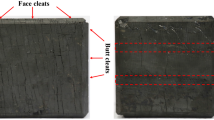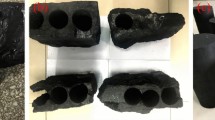Abstract
Water injection technology has been widely used to prevent and reduce coal caving during roadway excavations in extremely soft and loose coal seams. To evaluate the influence of this technology on the long-term stability of such roadways, a self-developed triaxial creep test system was adopted to obtain the creep behaviors of extremely soft coals with various moisture contents (0.95, 2.30, and 3.26%) at a 0.2 MPa confinement, the creep characteristics and failure modes were compared, the formation condition of a rare secondary creep phenomenon was discussed, and a nonlinear creep model was newly established. The findings showed the following. (1) Extremely soft and fractured coal was characterized by significant rheological features, i.e., a large creep strain, a fast creep rate, and susceptibility to accelerated creep failure. The cumulative strain in natural water state and after 328 h was 2.99%. The steady-state creep rate was as high as 4.89 × 10–5/h, which remained unchanged during the entire steady-state creep stage. These features are markedly different from those of other rocks. (2) When the moisture content increased to 2.3%, the creep strain reached 9.19% within 61 h, and the steady-state creep rate was 4.23 × 10–4/h. After the primary creep, there was an obvious secondary creep process, during which the secondary transient creep stage and secondary steady-state creep stage occurred successively. (3) As the moisture content increased from 0.95% to 3.26%, the ability of the coal sample to resist long-term deformation decreased, i.e., the creep duration before specimen failure decreased dramatically and the creep rate increased markedly; in particular, the steady-state creep rate increased in a power function. (4) A certain water content (~ 2.30%) and confining pressure were required for the occurrence of secondary creep process. (5) The proposed nonlinear creep model could describe the full creep stage perfectly, especially the tertiary creep stage in primary creep process and the entire secondary creep process.









Similar content being viewed by others
References
Bérest, P., Gharbi, H., Brouard, B., et al. (2019). Very slow creep tests on salt samples. Rock Mechanics and Rock Engineering, 52(3), 2917–2934.
Bieniawski, Z. T., & Bernede, M. J. (1979). Suggested methods for determining the uniaxial compressive strength and deformability of rock materials. International Journal of Rock Mechanics and Mining Sciences & Geomechanics Abstracts, 16(2), 135–140.
Cheng, C. (2014). Study on stability increasing mechanism and process parameters of coal wall water injection in soft coal seam. China University of Mining and Technology.
Deng, H. F., Zhou, M. L., Li, J. L., et al. (2016). Creep degradation mechanism by water-rock interaction in the red-layer soft rock. Arabian Journal of Geosciences, 9(12), 1–12.
Du, F., Wang, K., Zhang, X., et al. (2020). Experimental study of coal–gas outburst: Insights from coal–rock structure, gas pressure and adsorptivity. Natural Resources Research, 29, 2481–2493.
Eberhardt, E., Stead, D., & Stimpson, B. (1999). Quantifying progressive pre-peak brittle fracture damage in rock during uniaxial compression. International Journal of Rock Mechanics and Mining Sciences, 36(3), 361–380.
Gatelier, N., Pellet, F., & Loret, B. (2002). Mechanical damage of an anisotropic porous rock in cyclic triaxial tests. International Journal of Rock Mechanics and Mining Sciences, 39(3), 335–354.
Guo, H. Y., & Su, X. B. (2010). Research on the mechanism of gas emission inhibition in water-flooding coal seam. Journal of China Coal Society, 35(6), 928–931.
Han, H. Q., Wang, Z. J., & Guo, B. B. (2016). Coal wall spalling mechanism and prevention technology of unstable seam with soft roof, soft coal and soft floor. Coal Science and Technology, 44(4), 34–38.
Han, Y. J. (2013). Large cross-section slice for spalling and roof caving prevention technique of excavating in three soft coal seam roadway. Journal of Henan Polytechnic University (Natural Science), 32(4), 391–397.
Hou, R. B., Zhang, K., Tao, J., et al. (2019). A nonlinear creep damage coupled model for rock considering the effect of initial damage. Rock Mechanics and Rock Engineering, 52, 1275–1285.
Hu, B., Yang, S. Q., Xu, P., & Cheng, J. (2019). Cyclic loading–unloading creep behavior of composite layered specimens. Acta Geophysica, 67(2), 449–464.
Hu, Q., Zhang, S., Wen, G., Dai, L., & Wang, B. (2015). Coal-like material for coal and gas outburst simulation tests. International Journal of Rock Mechanics and Mining Sciences, 74, 151–156.
Jasinge, D., Ranjith, P. G., Choi, X., & Fernando, J. (2012). Investigation of the influence of coal swelling on permeability characteristics using natural brown coal and reconstituted brown coal specimens. Energy, 39(1), 303–309.
Jia, C. J., Xu, W. Y., Wang, R. B., Wang, S. S., & Lin, Z. N. (2018). Experimental investigation on shear creep properties of undisturbed rock discontinuity in baihetan hydropower station. International Journal of Rock Mechanics and Mining Sciences, 104, 27–33.
Jiang, Y. Z., Zhang, M. M., & Li, L. Q. (2008). Study on nolinear viscoelasto-plastic creep model of rock and its parameter identification. Chinese Journal of Rock Mechanics and Engineering, 27(4), 832–839.
Jing, S. G., & Lu, L. H. (2017). Research on formation mechanism and application of anchor structure for thick coal roadway in sliding structure zone. Journal of Mining & Safety Engineering, 34(5), 928–932.
Kang, H. P. (2016). Sixty years’ development and prospects of rock bolting technology for underground coal mine roadways in China. Journal of China University of Mining and Technology, 45, 1071–1081.
Li, X. S., Li, Q. H., Hu, Y. J., et al. (2021). Evolution characteristics of mining fissures in overlying strata of stope after converting from open-pit to underground. Arabian Journal of Geosciences, 14(24), 1–18.
Li, X. S., Li, Q. H., Hu, Y. J., et al. (2022). Study on three-dimensional dynamic stability of open-pit high slope under blasting vibration. Lithosphere, 2021(Special 4). Article ID, 6426550, 1–17.
Lyu, C., Liu, J. F., Ren, Y., Liang, C., et al. (2021). Study on very long-term creep tests and nonlinear creep-damage constitutive model of salt rock. International Journal of Rock Mechanics and Mining Sciences, 146, 104873.
Maranini, E., & Brignoli, M. (1999). Creep behaviour of a weak rock: Experimental characterization. International Journal of Rock Mechanics and Mining Sciences, 36(1), 127–138.
Meng, Q., Zhang, M., Han, L., Pu, H., & Nie, T. (2016). Effects of acoustic emission and energy evolution of rock specimens under the uniaxial cyclic loading and unloading compression. Rock Mechanics and Rock Engineering, 49(10), 3873–3886.
Meng, Q. X., Wang, J., Tao, Z. G., et al. (2021). 3D nonlinear analysis of stilling basin in complex fractured dam foundation. Lithosphere, 2021(Special 4). Article ID, 2738130, 1–11.
Pan, J. F., Ning, Y., Lan, H., et al. (2012). Water injection methods in coal bed based on experiments of water.immersion time effect of Qianqiu coal samples with burst trend. Journal of China Coal Society, 37, 19–25.
Sun, X. M., Miao, C. Y., Jiang, M., et al. (2021). Experimental and theoretical study on creep behaviors of sandstone with different moisture contents based on modified Nishihara model. Chinese Journal of Rock Mechanics and Engineering, 40(12), 2411–2420.
Wang, X. K., Song, L. B., Xia, C. C., Han, G. S., & Zhu, Z. M. (2021a). Nonlinear elasto-visco-plastic creep behavior and new creep damage model of dolomitic limestone subjected to cyclic incremental loading and unloading. Sustainaility, 13(22), 12376.
Wang, X. K., Xia, C. C., Xie, W. B., Zhu, Z. M., Song, L. B., & Han, G. S. (2021b). Long-term creep law and constitutive model of extremely soft coal rock subjected to single-stage load. Rock and Soil Mechanics, 42(8), 2078–2088.
Wang, X. K., Xie, W. B., Bai, J. B., Jing, S. G., Su, Z. L., & Tang, Q. T. (2020). Control effects of pretensioned partially encapsulated resin bolting with mesh systems on extremely soft coal gateways: A large-scale experimental study. Rock Mechanics and Rock Engineering, 53(8), 3447–3469.
Wang, X. K., Xie, W. B., Jing, S. G., Su, Z. L., Li, L. H., & Lu, L. H. (2018). Experimental study on large deformation control mechanism of surrounding rock of extremely loose coal roadway in gliding tectonics area. Chinese Journal of Rock Mechanics and Engineering, 37(2), 312–324.
Wang, X. K., Xie, W. B., Su, Z. L., & Tang, Q. T. (2019). Experimental development of coal-like material with solid-gas coupling for quantitative simulation tests of coal and gas outburst occurred in soft coal seams. Processes, 7(3), 1–23.
Yang, S., Tian, W., & Ranjith, P. G. (2017). Experimental investigation on deformation failure characteristics of crystalline marble under triaxial cyclic loading. Rock Mechanics and Rock Engineering, 50(11), 2871–2889.
Yang, W., Zhang, Q., Li, S., & Wang, S. (2014). Time-dependent behavior of diabase and a nonlinear creep model. Rock Mechanics and Rock Engineering, 47(4), 1211–1224.
Zhang, Z. L., Xu, W. Y., & Wang, W. (2011). Study of triaxial creep tests and its nonlinear visco-elastoplastic creep model of rock from compressive zone of dam foundation in Xiajiaba hydropower station. Chinese Journal of Rock Mechanics and Engineering, 30(1), 132–140.
Zhang, Z. L., Xu, W. Y., Wang, W., & Wang, R. B. (2012). Triaxial creep tests of rock from the compressive zone of dam foundation in Xiangjiaba hydropower station. International Journal of Rock Mechanics and Mining Sciences, 50, 133–139.
Zhao, Y. L., Wang, Y., Wang, W., Wan, W., & Tang, J. (2017). Modeling of non-linear rheological behavior of hard rock using triaxial rheological experiment. International Journal of Rock Mechanics and Mining Sciences, 93, 66–75.
Zhao, T., Gong, P., Yetilmezsoy, K., Bahramian, M., & Liu, C. (2021). Dynamic failure and stability model analysis of thick and hard rock with wedge-structure immediate roof occurrence. Geomechanics and Geophysics for Geo-Energy and Geo-Resources, 7, 1–15.
Acknowledgments
This work was financially supported by the Open Fund of State Key Laboratory of Coal Mining and Clean Utilization (2021-CMCU-KF011).
Author information
Authors and Affiliations
Corresponding author
Ethics declarations
Conflict of Interest
The authors declare no conflict of interest.
Rights and permissions
Springer Nature or its licensor (e.g. a society or other partner) holds exclusive rights to this article under a publishing agreement with the author(s) or other rightsholder(s); author self-archiving of the accepted manuscript version of this article is solely governed by the terms of such publishing agreement and applicable law.
About this article
Cite this article
Yang, J., Wang, X., Xie, W. et al. Creep Behaviors of Extremely Soft and Fractured Coal Rock with Different Moisture Contents and Rare Secondary Creep Performance. Nat Resour Res 32, 357–371 (2023). https://doi.org/10.1007/s11053-022-10140-w
Received:
Accepted:
Published:
Issue Date:
DOI: https://doi.org/10.1007/s11053-022-10140-w




